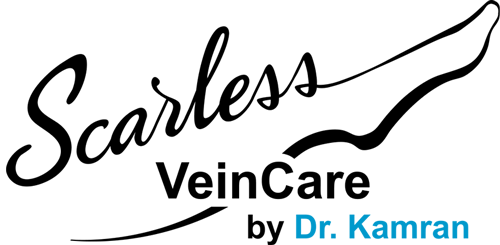FAQs on Vein Problems
What are varicose veins?
Varicose veins are abnormally swollen or stretched veins that bulge from the surface of the skin in a rope-like manner. This occurs when valves become incompetent and prevent normal blood flow from the larger deep veins into the smaller superficial veins.
What are spider veins?
Spider veins or broken capillaries are the small and irregular veins that are purple or blue in color with a web-like appearance. In many cases, achieving good results in the treatment of spider veins depends on the successful treatment of both the deeper vein system and feeder veins. This simple fact is commonly ignored by less experienced physicians, which often leads to the spider veins returning later.
What are the symptoms?
Sadly, many people (and even physicians for that matter) don’t associate these common symptoms with venous disease. Often people will simply attribute these symptoms to aging or extended periods of time on their feet. It’s important to realize that leg pain is NOT a normal condition under any circumstances. As with any progressive disease, it is best to seek treatment as soon after symptoms arise as possible. Here are some of the more common symptoms of venous disease.
- Aching Legs
- Heaviness
- Swelling
- Dull Pain/Burning
- Itching
- Restless Leg
- Cramps
- Tiredness
- Sharp Pain
- Discoloration
- Throbbing
- Leg Sores/Ulcers
What are the causes?
Varicose veins are a progressive disease. Heredity is the most common factor for developing varicose veins. Other causes include pregnancy and obesity. Standing for prolonged periods of time or on a regular basis may also aggravate the problem by allowing blood to pool in the vessels of the legs. Spider veins may occur in combination with large varicose veins as a result of increased vein pressure or on their own due to increased communication between the venous and arterial system through tiny shunts (short cuts).
What are the treatments?
The most successful treatment begins with a complete and comprehensive evaluation of your vein problems by a trained and qualified medical team. A good treatment plan is based on an ultrasound mapping of your vein system to find the root of each individual’s problem. Each case may have more than one option for treatment and may require a combination of treatments. Those can include:
- VeinGogh VeinGogh is the newest treatment for spider veins. This simple and affordable procedure is effective on any part of the body and leaves no scarring. There is no recovery time and you can immediately go into the sun.

Before & After VeinGogh Procedure
- Sclerotherapy Sclerotherapy is a non-invasive method of injecting a medicated solution into the diseased vein. The vein immediately shrinks and then over a period of a couple weeks begins to dissolve completely away. The procedure takes place right in the office and takes only minutes. Here are before and after close-ups of the skin on a patient’s leg.

- Compression Hose Compression hose often help circulation. We are proud to offer the finest medical grade compression hose on the market, with men’s and women’s hose available in a wide variety of styles and colors. And, we have trained fitters to assure the hose fit properly for maximum effectiveness.

- Tattoo Removal
Tattoo removal once meant gambling low odds of success on a high risk of scarring and pain. Tattoos are designed to last forever, but as more and more people seek reversal of these deeply embedded ink deposits, technology too has kept pace with improved methods of safety and efficacy. The most advanced technology comes in the form of Q-switched Nd:YAG lasers using PhotoAcoustic Technology which safely penetrate the skin and target each tattoo ink color with specific wavelengths, causing tattoos to gradually fade during a course of 5 to 15 treatment sessions. - Stain Removal
Advanced laser technology with Q-Switched Nd:YAG wavelengths offers a proven method to permanently remove most brown spots, freckles and unwanted pigment. The light vibrates and shatters the pigment and breaks the melanin into micro-particles, lightening and removing the dark, aging spot. Most pigmented lesions disappear after 1 to 2 treatments; deeper lesions may require more treatments. - Aging Spots/Sunspots on Legs
In the past, physicians only used ablative lasers to wound the top layers of the skin. While these aggressive lasers are still used to treat deep wrinkles and advanced photodamage, they can mean significant downtime for the patient. RevLite is a non-ablative laser that uses PhotoAcoustic TechnologyPulse (PTP) energy for quick full-face treatment options with no downtime and minimal discomfort. As new collagen synthesizes, lines and wrinkles diminish while the facial structure appears and feels firmer and smoother.




